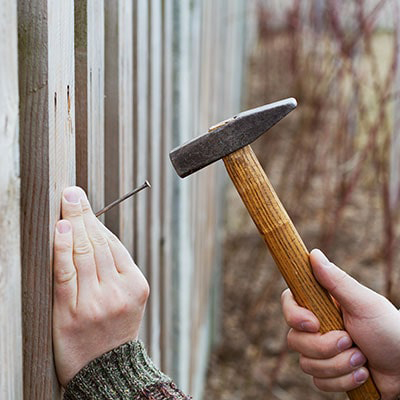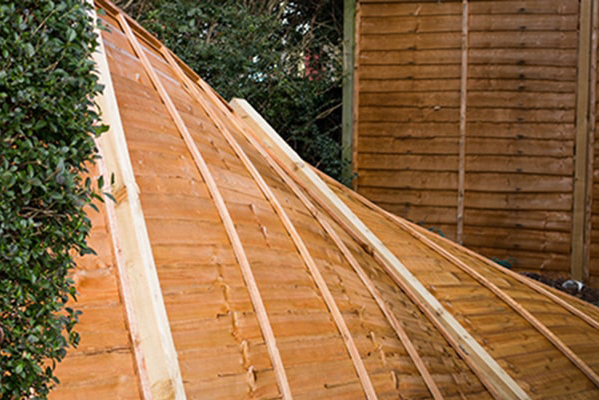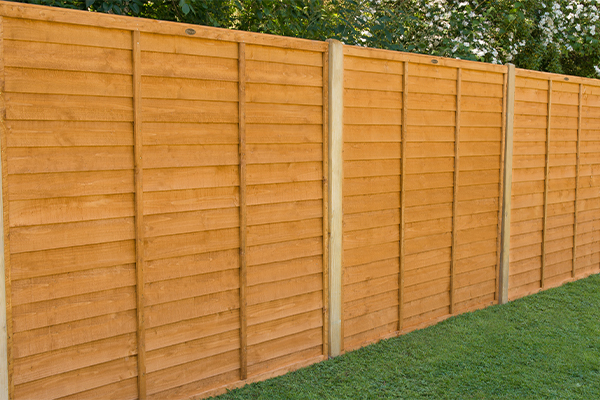![Guide to Fence Post Repair: Replacing or Fixing a Rotten Fence Post [UPDATED]](https://www.buyfencingdirect.co.uk/media/magefan_blog/EGFP_2-feature-image-12.jpg)
Putting up wooden fencing for yourself is a very rewarding process and is easier than you think. Fences are often overlooked and taken for granted, but with a little effort, they can enhance your garden environment. But from time to time, fence post repair will become necessary, we discuss ways to prevent this as well as how to replace a fence post below.
Editor’s Note [08.07.2024]:
Our article about how to replace a damaged or rotten fence post was originally published on January 17, 2017. Today's update has been extensive with many new sections being added. Read on to learn about how to complete fence post repair (including rotten fence repair). We provide a list of all the tools you will need. Full processes are provided for how to replace a fence post as well as fixing a fence post with a repair spur.
Introduction to damaged or rotten fence post repair
Fence post repair is a necessity from time to time in any garden featuring fencing. Whether you have a wooden, metal, or concrete fence post a range of different issues will arise from pests to corrosion to the good old British weather. Although it is always best to practice preventative techniques, which we discuss below, even then occasionally fence post repair and the need to fix a rotted fence post (for wooden fence posts) will become a necessity.


How to identify when fixing a fence post is needed?
Over a period of years, your once proud fence posts will begin to deteriorate, especially if the preventative measures we discuss later are not followed. This will affect the structural integrity and visual appearance of your fence posts. There are six main areas of identifying damage in fence posts and spotting when fixing a fence post will be needed. These are chipping, cracks and splits, leaning and instability, pest infestations, rotting wood, and rust & corrosion. We now discuss each of these broken fence post issues in turn:
Chipping and cracking
Mainly affecting concrete posts, chipping and cracking can arise. Concrete is an exceptionally durable material, but it is susceptible to freeze and thaw cycles during colder periods.
Cracks and splits
Particularly with wooden fence posts, cracks and splits arise with age and exposure to severe weather conditions. Small cracks and splits can be considered normal, it is larger ones that are problematic. Large cracks and splits affect structural integrity, look unsightly and will attract burrowing pests.
Leaning and instability
One of the areas of structural integrity deficit is leaning and instability. Even if it is only one fence post that is leaning it will easily affect an entire fencing run. This is easy to test and involves checking if the fence post moves when leaned against.
Pest infestations
Various pests can affect wooden fence posts including insects such as beetles (various species), borers, and weevils. Rats and mice love to gnaw which can also be a problem. Pest infestations if unaddressed worsen over time and will compromise a fencing structure and could even lead to collapse. Look for sawdust-type debris and small visible holes as tell-tale pest infestation signs.
Rotting wood
Among the most common issues affecting fence posts is rotting wood. This is most likely to occur directly in the area where the fence post meets the soil. This is why gravel boards are often placed between the fence post and the ground to create an anti-rotting barrier and reduce the need to fix a rotted fence post.
Gravel boards are placed between the fence posts and the ground and act as a protective barrier. To identify rotting look for discolouration, soft, or crumbling wood and in more advanced stages the wood will easily break in your hands.
Rust and corrosion
Only applying to metal fence posts, rust, and corrosion if left will lead to the entire fence needing to be replaced. Signs of rust and corrosion are easy to find with an orange/red colour and will eat away at the metal over time.


How to replace a fence post which is damaged
Below we provide the tools needed and a step-by-step approach for how to replace a broken fence post.
Tools needed
The following are all the tools you could use to replace a fence post (primarily wooden), but some would also be useful in concrete and metal fence post replacements:
- Drill with bits
- Fencefast repair spur
- Saw
- Screwdriver or hammer
- Screws or nails
- Shovel and/or post hole digger
- Sledgehammer or mallet
- Spirit level
- String line and pegs
- Tape measure
- Wheelbarrow
Other items that are needed include gravel (for drainage), safety equipment (gloves, goggles, and ear protection, as well as concrete mix, where you need to refix the base of the fence post.
The process of replacing a fence post
To replace (not fix) a fence post, including how to replace a rotten fence post, the process would be:
- Inspection - complete the checks as identified in our identifying signs of damage in the fence posts section above
- Remove soil around the post - expose the fence post base by removing the soil around the post
- Stabilise the fence panels - next ensure that the fence panels are stable and will not topple over
- Remove the post - now remove (typically through cutting or unscrewing) the damaged post from the fence panels. Once panels are detached then lift the post out of the hole
- Prepare a new hole - either reuse the old hole (if suitable) or dig a new one to the depth required, remembering the one-third underground rule
- Add gravel - next add gravel in the hole to aid with soil drainage
- Insert your new post - place your new fence into the hole, taking time to ensure the height and alignment are correct, this part is likely to need two people
- Secure the post with concrete - prepare your concrete and then pour it into the hole around the base of the post
- Wait for the concrete to set - now patience is needed whilst you wait for the concrete to set
- Reattach the fence panels - next the fence panels can be reattached, typically with nails or screws
- Check for levelness and alignment - use the spirit level to ensure the post is vertically straight. Also, check it is properly aligned with the remainder of the fence run
- Fill the hole - fill the remainder of the hole with soil, ensure it is compacted firmly
- Treatment - if the wooden fence post is dip treated, then it can be treated with a high-quality wood preservative. A paint or stain finish can be applied later (Click here for more details on when to do this). A metal post should be treated with a top-quality rust inhibitor
Repairing and fixing a damaged or rotten fence post
We recommend repairing and fixing a damaged or rotten fence post using a Fence Fast repair spur, which is available to buy here. This is a specific type of metal bracket we sell, which is used to repair and support a wooden fence post, which has become damaged or rotten at the base. Using this spur is much cheaper as it avoids needing to replace the entire post. A repair spur is ideal for rotten fence post repair including fixing of ground-level rotting damage (the most common fence post issue).
The process where a Fence Fast repair spur is used is:
1 to 3) Repeat steps 1-3 above (inspection, remove soil, and stabilise the fence panels)
4) Position the repair spur – align the spur to the damaged section of the post
5) Drive the spur - using a sledgehammer, drive the spur into the ground until you believe it is firmly in place and anchored
6) Secure the post - bolt or screw the damaged post to the repair spur
7-8) Repeat steps 11-12 above (check for levelness, and fill the hole)
9) Reattach the fence panels – now secure the fence panels back to the post
10) Treatment – repeat step 13 from above
Preventative measures for fence post durability
"Prevention is better than cure" or so the old saying goes. There are many steps you can take to avoid the six problems we mentioned earlier - chipping, cracks & splits, leaning fence & instability, pest infestations, rotting wood, and rust & corrosion. Follow the advice below to take preventative action.
Regular inspections are necessary and will head off many of the following issues at an early date and prevent significant issues from developing, it has similarities to regular visits to the Dentist!


To avoid chipping - relating to metal fence posts, we recommend applying a rust inhibitor or a paint sealant. Caps and finials will reduce chipping at the top of fence posts. Always buy metal posts with a galvanised zinc layer, which enhances rust resistance.
To avoid cracks and splits - fill and seal cracks as soon as they are seen to reduce damage. Adding caps or finials is decorative but will also prevent cracks and splits from emerging at the top of the fence post. Try to avoid direct soil contact wherever possible
To avoid leaning and instability - a main factor is ensuring adequate fence post depth, remember the one-third rule! Make sure drainage is sufficient. Check for loose connections regularly and fix them where found as these lead to instability. In high wind areas using panels which allow the wind through (e.g. slatted) reduces pressure. Be careful about overloading with hanging baskets and/or heavy climbing plants, which can create instability.
To avoid pest infestations - treated wood will often deter pests from munching on the wood, insect-repellent coatings have a similar result. Seal any cracks as soon as they are seen to deter burrowing pests such as beetles and eliminate the need for rotten fence post repair in the future. Using gravel boards or fence supports will deter ground pests such as ants from attacking the base. If all else fails, you can always call in pest control experts.
To avoid rotting wood - we strongly recommend the use of gravel boards or metal fence post supports to raise the post above ground level. Either use pressure treated wood, or if you have dip treated apply a high-quality wood preservative at least annually. Adding proper damage through gravel will prevent water accumulation, which leads to fence base rot. Also, keep areas around fence posts free of vegetation as this acts as a moisture trap, which leads to rot.
To avoid rust and corrosion - apply a rust inhibitor regularly to prevent medium-long-term rust and corrosion. Buying galvanised steel or stainless steel fencing and/or accessories will resist rust and corrosion. Clean off any dirt, debris, or grime regularly to deter moisture build-up (avoid the use of abrasive cleaning chemicals). Keep hinges and moving parts lubricated to prevent rust. Topping off with caps or finials will prevent rust and corrosion at the top of the fence post.


Conclusion: maintaining a sturdy fence
The objective is always to maintain a sturdy fence but as we conclude, sometimes it will become a necessity to complete fence post repair. Identifying damage early is imperative and above we identified six main areas, which cause fence post damage. We explain above the different types of issues affecting fence posts and separate them for wooden, metal, and concrete fence posts.
Read our step-by-step processes above for how to replace a fence post as well as fixing with a Fence Fast repair spur. Read our preventative measures section, which details actions you can take including regular inspections, using rust inhibitors on metal posts, sealing cracks, ensuring proper post depth, using pest repellents, and employing gravel boards or post supports.


Related articles
Explore these articles from the Buy Fencing Direct blog for additional tips on how to repair a fence panel and other related topics:
- How long can it take for my landlord to fix my fence?
- How to repair a wooden fence
- How to spot damage and fix broken fence panels
Contacting Buy Fencing Direct
For additional guidance about fixing a fence post and how to replace a fence post our friendly team are available. They have many years of experience in advising about fencing and outdoor living products.
At Buy Fencing Direct, we sell a range of high-quality fencing panels and accessories. So, if your current fencing is rotten or damaged beyond repair, why not browse and shop through our selection of new fencing in a range of sizes and styles today?
For support and advice about rotten fence post repair and other technical advice, our contact details are:
- Phone calls - 0333 003 0515
- E-mails - our contact form should be used to send emails
- Text chat – use our live chat app to chat with us in real-time




